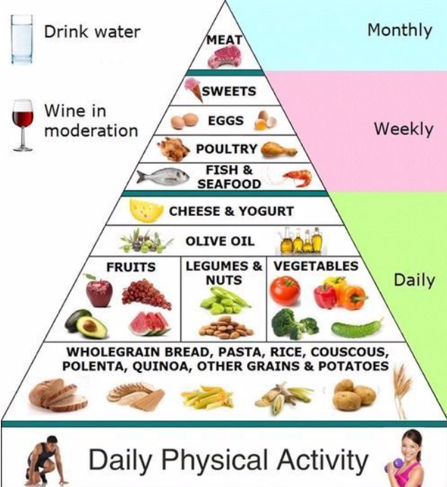As I enter my third month living in Italy, I have had a fair amount of time to experience the Mediterranean Diet. The Mediterranean Diet is known around the world as one of the healthiest eating plans we can follow. It is linked to lower blood pressure, risk of heart disease, blood sugar, and other chronic diseases. Despite its popularity, many people are not aware of its individual characteristics. I hope to share some of the finer points of the Mediterranean Diet so you will be able to see how easy it is to incorporate aspects of the diet into your everyday life and achieve a healthier, longer, happier life.
When most people think of the Mediterranean Diet, they think of olive oil, fish, and lots of fruits and vegetables. While this is definitely true, it is a little more complex. Unlike the United States’ “MyPlate”, which focuses on what should be eaten at each meal, the Mediterranean Diet guides what foods should be consumed daily, weekly, and monthly. Foods that can be eaten every day are whole grains, fruits, vegetables, beans, nuts, olive oil (the main fat source), and dairy, which is mostly yogurt and cheese. Weekly foods consist of fish and poultry, and sweets in moderation. When people think of Italian desserts, many rich sweets such as cannolis and gelato come to mind. While these are definitely available and enjoyed, they are reserved for special occasions. Typically, to finish a meal, Italians will have a piece of fruit or a small fruit salad. This is a practice that is easy to adopt and satisfies your sweet craving without breaking the calorie bank.
As I mentioned earlier, the Mediterranean Diet is a lifestyle, not a short-term diet. It is designed to sustain and nourish you. Like any well-balanced diet, exercise is an important part of the big picture. On the pyramid (seen below), physical activity makes up the foundation. This means that daily activity should be prioritized along with eating the appropriate amount of the different foods.
As a nutrition student, the Mediterranean Diet is frequently discussed in my classes. For this reason, I knew the basics of it before arriving in Italy. However, I quickly learned that knowing the theory and practicing it are two very different things. A big part of the diet is portion control and moderation. One of the first things I noticed, was that Italians will take their time with eating, and stop when they are full. Food is served in smaller portions and it is almost unheard of to have more than one or two glasses of wine with a meal. Certain items, such as salad dressing are not available anywhere, even large grocery stores. So, if you are a ranch fanatic, you will need to adapt before ordering a salad here. Typically, they are dressed only with olive oil and balsamic vinegar, which can take some getting used to.
While there are some regional variations of the Italian diet, the Mediterranean Diet is the most common lifestyle in Italy. Many may be surprised to find how similar it is to their own diet. The Mediterranean Diet does not adhere to particular portion sizes, tout strange products, and allows for a variety of foods, making it extremely easy to adopt as your own diet without changing too much. By following the Mediterranean Diet, you too can experience all its health benefits. Here’s to a happier and healthier and healthier you!
by Grace Stott, Guest Blogger and UVAC Member

